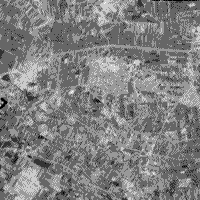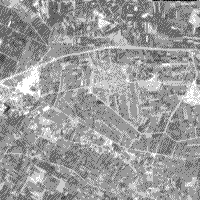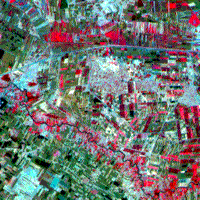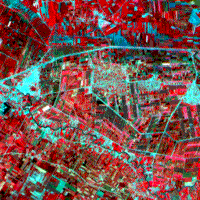

Agriculture in SW Kansas and Morocco
We turn momentarily to a second SPOT subscene (10 km [6.2 mi] on a side), taken on May 11, 1986, over an area near Garden City in southwestern Kansas, a major wheat producing area in the Great Plains agricultural belt. The most striking feature is a series of circular patterns ranging from less than 0.4 to about 0.8 km (1/4 - 1/2 mile) in diameter (about the same sizes as the Kenyan farm plots). Some people are astounded when they see these features from an airliner flying across the Midwest.
|
Center Pivot Irrigation System, Northern California, Mount Shasta in the Background |
The system uses a long water pipe that is mounted on motorized wheels and has one end connected to the water line at the center of the field. When operating, the irrigation system swings in a circle,sprinkling water as it rotates. (Several fields actually show a dark linear radius which is this interesting system.) The red circular fields are mostly plantings of winter wheat that are nearing harvest. Those circles in various shades of blue (note the darker patterns of moisture) are fallow at this time, but most of them have probably been seeded for spring wheat, or will be. Note the road patterns that outline squares. These roads follow survey lines that coincide with the one-mile squares, representing sections in the American Township and Range surveying system. The worm-like red pattern within a section in the upper center is an 18-hole golf course, which appears in the middle of nowhere (compare it with the one in the Morro Bay scene).
3-7: What is an obvious disadvantage to the circular irrigation system? ANSWER
Our final SPOT agricultural scene is actually two images of the same area, obtained two months apart during late winter and spring in northwest Africa. The purpose here is to illustrate changes in vegetation as the crop calendar progresses. The area is the Ghard plains, not far from the Atlantic coast in western Morocco, near Casablanca. This granery belt is a main producer for that country. The crops include beets, sugar cane, wheat, and rice.
Let's start by looking at the SPOT b and 1 (green) image (above) acquired on March 14, 1986. A first reaction may be that the landscape is mostly farmland, with almost all plots being smaller than in the Kenyan and Kansan scenes. The next obvious characteristics are the small river (Oued Oum er Rbia) and the major roadway to El Jadida on the west and Settat on the east, met by several feeder roads. Note also some very dark areas in the image.
These dark areas are nearly black in band 3 (IR) (the left image from below). They are probably bodies of water, with some being irregular in shape that represent standing water from spring floods and others in field-like shapes are probably irrigated rice fields. Only a fraction of the fields (particularly along the river) are rendered in bright tones, indicating that most crops are not growing much yet.
 |
 |
But, when the same area is imaged in SPOT band 3 on May 10, (the bottom, left image from above) a much larger percentage of fields are in brighter tones, suggesting many crops are growing. The black areas of flooding are reduced, but rice fields remain about the same tone. The image shows towns in medium-gray tones. Tiny bright patches dot the one in the center, indicating numerous trees.
The pronounced differences in the extent of active crop and tree vegetation, are much more evident when comparing false color images first for the March scene (left) and then the May scene (right).
 |
 |
In the March image, an estimated 30% of the fields have actively growing crops, while in the May image, this increases to about 80%. The areas of open water in the March scene greatly diminish in the May scene. Some of the areas with water show up as dark red (typical of rice fields) in the May view. In the March scene, a large part of the land not in crop growth appears in a dark brownish-green color which in false color is the expression of soils that are naturally reddish-brown.
3-8: There is at least one town in this scene, maybe more. Where? ANSWER
Image-processing techniques for change detection can help to emphasize major distributions of active versus dormant, or absent, vegetation. One simple approach is to make a ratio image (divide eh DNs of one image by the other ) in the same bands, usually in the IR, for two dates. This results in very bright tones wherever vegetation is prevalent in the dividend's date but not in the divisor's date. (See Section 1-15 for explanation on ratioing) The opposite is true if the vegetation distribution is reversed because the dates are reversed. If vegetation is present to similar extents on both dates, the ratio image tones will be moderately gray. We attempted to do a ratio image for the March and May scenes but failed because the two scenes did not coincide. The images were taken on dates when the orbits were not exactly aligned. IDRISI, while it can generate ratio images, does not have the precise program for co-registering (aligning) two closely related images where one is slightly offset from the other. Co-registering images requires a computer algorithm that can execute a "rubber-stretch fit").

Collaborators: Code 935 NASA GSFC, GST, USAF Academy
Contributor Information
Last Updated: September '99
Webmaster: Bill Dickinson Jr.
Site Curator: Nannette Fekete
Please direct any comments to rstweb@gst.com.